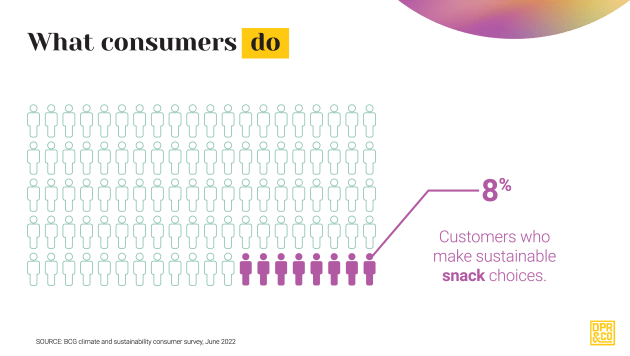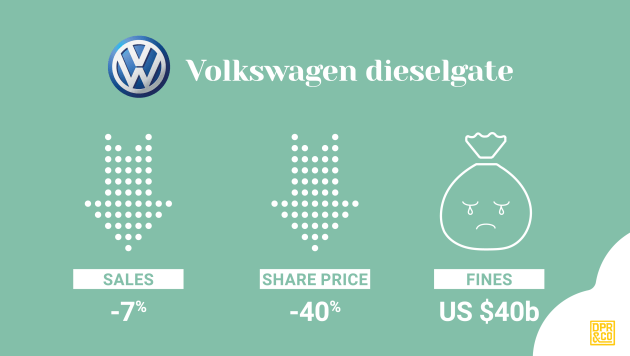Behind every ambitious ESG marketing initiative lies a massive consumer behaviour challenge. Consumers claim that they will reward us for sustainable practices. But at the checkout, only a small percentage of them actually do.

The say–do gap: A brutal marketing reality

The say–do gap is a concept in consumer behaviour that’s shockingly underestimated in practice. Consumers claim they’ll reward brands that adopt sustainable practices. But at the moment of truth, when price, habit, and convenience kick in, their actions tell a different story.
In snacks, 69% of consumers express concern about sustainability. But only 8% actually follow through at the checkout. The same pattern shows up in beverages (68% down to 12%) and grocery shopping more broadly (69% to just 7%).

When there’s a premium to be paid, the gap is wider still. 84% of airline travellers say they will pay to offset their carbon dioxide emissions, at around $2 per booking. Only 3% tick the offset box at the checkout.
This is simply human nature. When it comes to sustainable purchasing decisions, consumers rarely deliver on what they say they will do.
But what happens when the boot is on the other foot? What happens when businesses don’t deliver on the sustainability promises they make to consumers?
They may not reward you for getting it right. But they will punish you for getting it wrong.
Take Volkswagen’s infamous Dieselgate. This global behemoth developed a hack on emissions tests, switching on emissions controls only when the vehicle was undergoing testing. Under normal driving conditions, the vehicles in question vastly exceeded emissions limits. The consequences of this deception were staggering: a 40% share price drop, $40 billion in fines, and a reputation still recovering a decade later.

Or Nestlé, expelled from the Roundtable on Sustainable Palm Oil for not living up to their sustainability pledges, facing consumer backlash amounting to US$6.6 billion in revenue and a lasting goodwill impairment in the process.
In both cases, the disconnect between what brands said and what they did triggered lasting damage. Trust is fragile. Once broken, it doesn’t heal quickly.
It’s agreed then, that we must deliver on our sustainability promises to our customers. The big question is – can we overcome the say-do gap? Can we actually convince customers to buy our product based on our environmental claims?
The answer is yes. But it’s difficult.
How do you get customers to reward you for sustainability initiatives? Be new. Be true.
To win customers over, brands need to cut through the scepticism and get serious about what it takes to change consumer behaviour.
So how do you make people care about your fibre packaging initiative, low-impact dyes or reduced freight emissions?
With two simple words: new and true.
Being new matters, because our brains are hardwired to respond to novelty. This isn’t just marketing speak, or even psychology. It comes down to our very physiology. The reticular activating system, a filtering mechanism in our brainstems, prioritises new information and discards the familiar. It’s the new information that reaches conscious awareness. That’s why fresh ideas grab attention, while stale messages are ignored. So say something new. And if you haven’t got anything new to say, you must find a new way to say it.
The second word is true. Newness isn’t enough on its own. Authenticity anchors novelty. Without truth, “new” becomes gimmicky, insincere, irrelevant and worst of all, distrusted.
This should be your litmus test for any sustainable marketing initiative. Is it new? Is it true? If it passes both, it stands a real chance of engaging consumers, generating earned media, and reinforcing long-term brand value.
A New and True approach to sustainability
Consider packaging through this lens. A switch from plastic to fiberboard might seem mundane. But framed in a way that’s new, perhaps by showing how it enables local composting or reduces shipping emissions. And true, with verifiable data, accreditations, or third-party endorsements. It then becomes compelling.
The future of sustainable branding
Sustainability isn’t just a checkbox. It doesn’t live in one department. It lives in the space between departments, in the consistency of action and message.
It’s a collective act that requires collaboration across disciplines and a relentless commitment to fresh and truthful storytelling.
When brands embrace that mindset and test every initiative against the simple filter of New and True, they won’t just earn attention. They’ll earn trust, loyalty, and long-term relevance.
That’s the kind of sustainability that sticks.
Richard Ralphsmith is Co-founder and Executive Creative Director of DPR&Co Advertising










